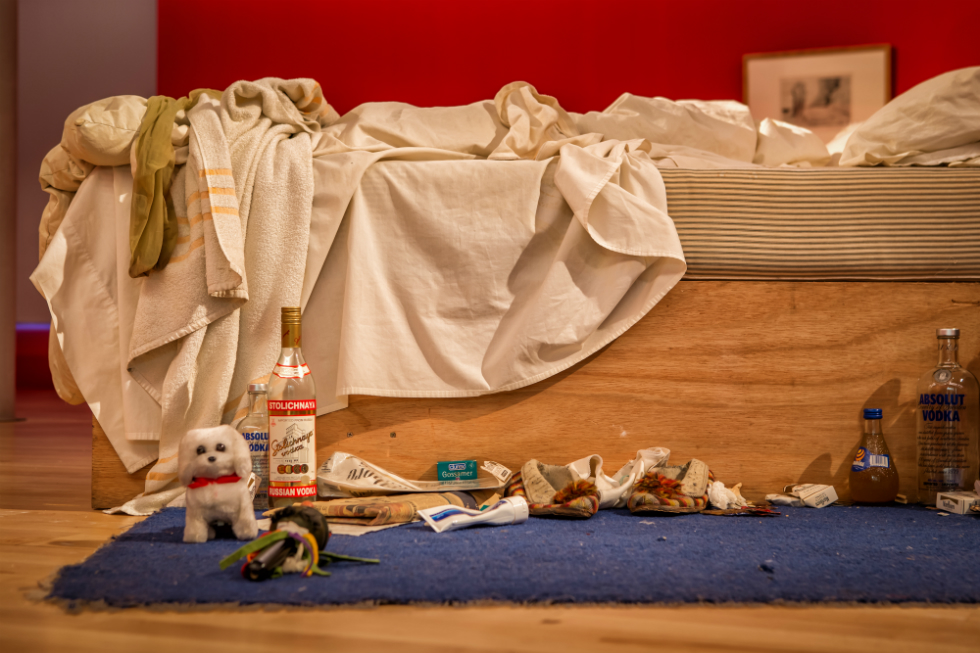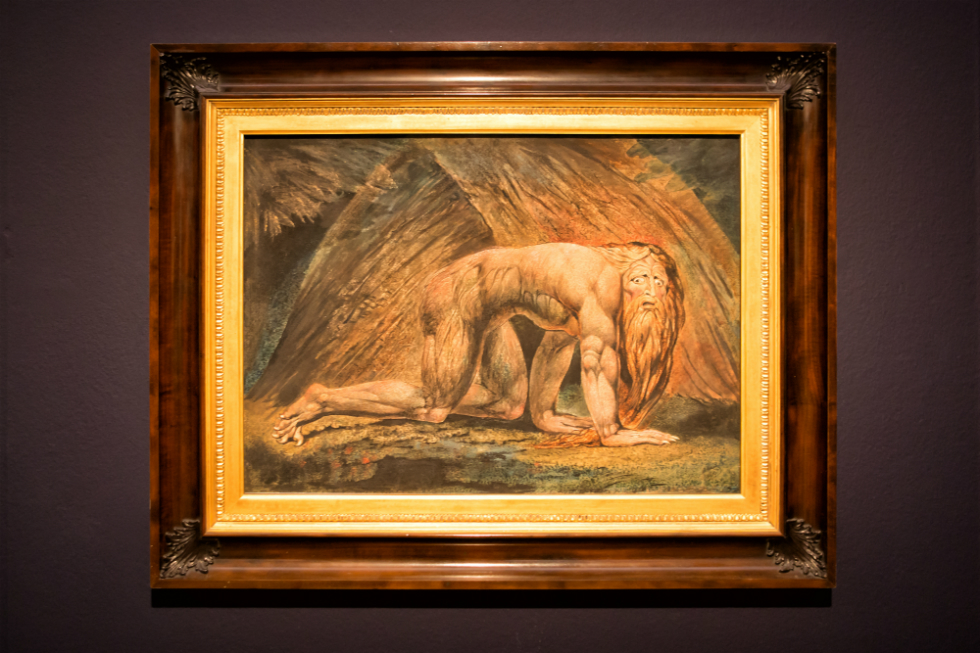“Uncompromising, naked, blunt… Humanity in extremis”: Tracey Emin And William Blake @ Tate Liverpool — Reviewed

In a new exhibition at Tate Liverpool, Liz Mitchell navigates a sobering variety of portraiture, from two very different mavericks…
Blood red walls and a stew of dirty sheets. Fag butts and corn plasters; vodka bottles, used tissues, a razor and a pregnancy test. An unmade bed is a shameful thing. My grandmother was definitive in this respect; clean knickers and made bed are the baseline of self-respect. When Tracey Emin’s My Bed first went on display in 1999, it caused outrage, both moral and critical. Disgusting self-indulgent wallowing? Cheap self-promoting shock tactics? A case of emperor’s new (bed) clothes? O Rose, thou art sick.
Seen in the flesh (so to speak) at Tate Liverpool in 2016, however, it’s less shocking than one might expect. The stains are old now and it doesn’t smell. It should be a foetid fug of bodily secretions, palatable only to the person whose private nest it has become. But then, it’s twenty years since a sweaty, leaky, boozed up body sought refuge here from a world of anguish. It isn’t an unmade bed anymore. It’s an artwork. It must be a curious thing to stage; how does one artfully place an overflowing ashtray, just so? Preserve a squeezed out tube of KY jelly and a pair of discarded tights with all the care and expertise deployed for Old Masters? This bed has become an idea, a memory, a remnant of some past private hell transformed into multi-million pound art commodity.
In this sense, it is discomfiting in the extreme. In the pristine galleries of Britain’s premier art institution on a sunny autumn morning, surrounded by well-dressed people in their gallery-going shoes (myself included), I am conscious of having walked down here, through the city, past people sleeping in doorways. Respectability is a thin veneer. And this heap of detritus is a sorry sight. Uncompromising, naked, blunt – this is how messed up life can be, it seems to say — see anything you recognise?
Because, really, haven’t we all got unmade beds tucked away somewhere? Times when everything’s got out of control, gone horribly wrong, when all we could do was hide beneath the covers? For all our composure, presentation and grooming, we are, at times, little more than fragile ego and animal instinct. Bed is where we are at our most base, our most vulnerable. Where we go to ground. Site of conception, birth and death, bedding soaks us up in all our messy liquefaction — unwashed, it goes on doing it till the sheets are stiff and brown.

Perhaps it’s a fundamental necessity that teenagers’ bedrooms go through a cesspit phase. When Thomas the Tank Engine and Barbie lose their magic. When bodies start behaving in powerfully overwhelming and unpredictable ways. When life becomes so much more complicated than it once seemed and longed-for autonomy brings both ecstasy and terror. Incriminating bedsheets and a midden of rubbish strewn across the floor are perhaps an inevitable consequence. Private sanctuary-cum-dirty protest-cum-cry for help. Fuck off out of my room.
So much comes bubbling up to the surface on encountering this artwork. Against expectation, I loved Tracey Emin’s My Bed. I found it sobering, provocative, compassionate. A space in which to contemplate one’s own dirty bedlinen. And that of one’s fellow human beings. How appropriate, then, to pair it with the strange and visceral humanity of William Blake. The loud-mouthed YBA and the 18th century visionary. Blake is now well-established in literary and artistic canons; his poetry is studied by sixth formers, his genius an accepted truism.
But in his own time he was an oddity, an outcast whose weird nightmare visions put him beyond the pale of the Academy. And when you actually look — really look — at his work, it is mighty strange. If the body has gone from the bed in this room, it is there in all its tortured and fallible beauty around the walls. Hairy bodies, winged bodies, bodies consumed by flames – prostrate, on all fours, open-mouthed and naked. Humanity in extremis.
From a distance, these works look beautiful; exquisitely etched, delicately coloured in watercolour and tempera. But bad things are happening. I think. It can be hard to tell. Biblical Old Testament themes, sin, torment, the pleasures and pains of flesh, are re-told through a complex private mythology. Two small prints captured my attention in particular, in part because, like much of Blake’s work, being small only magnifies their potency. Plates from The First Book of Urizen of 1796. Densely coloured in black and red, each contains a single figure, oddly luminescent against an inky ground, bound by the tightness of the frame around them. A robed and bearded man carries a heavy red and black globe, radiating spikes.
“Fearless tho in pain / I travel on”, reads the caption, and indeed grimly he proceeds, striding forward, pushing through the frame towards the second plate; a naked figure bent double, hands pressed tightly to the sides of the head, draped over the same veiny mass of red. It is impossible to differentiate between the figure’s lank falling hair and the bloody matter beneath, reaching upwards in sinewy threads. It is a tiny vision of agony, described in delicate copper-plate script below — “Vegetating in fibres of Blood”.
To the visitor who is not versed in Blakean symbolism, the specifics of this narrative are unclear, though the red globe might be a foetus, the beginnings of life. But the sense of bodily torment is unmistakeable. In life we are in death. Blake’s fascination with the body is not just as symbol, but as blood and bone and muscle and flesh. It is divine and pathetic, beautiful and repellent. Above all, it is vulnerable. And it is this, portrayed with such ferocious compassion that makes Emin and Blake such a fruitful pairing. Blake was a wordsmith as much as an image-maker. Emin too uses text in much of her work. But no words are required here to explain the unmade bed. In fact, maybe it is the failure of words, the failure to be heard, recognised, understood, that is so powerful about it. A member of Tate Liverpool’s Community Collective, in the audio commentary that accompanies the exhibition, articulates this beautifully:
“This is what it can be like, what it was like. This is how I deal with it, because it’s the only thing I can do”.
Earlier in the morning, on my way to the Tate, I gave a man a cigarette – he was sitting on the pavement, by a cashpoint, paper cup at his feet and head in his hands. What could I do in all my middle-class guilt but offer him a fag, a moment of mutual recognition in a shared dirty habit – and then walk on. A few hours later I passed by his spot again – he was gone. In some ways, we aren’t so very different, he and I.
Liz Mitchell
See Tracey Emin and William Blake: In Focus at Tate Liverpool from 18 September 2016-3 September 2017 — FREE
Install images courtesy Pete Goodbody, with thanks





